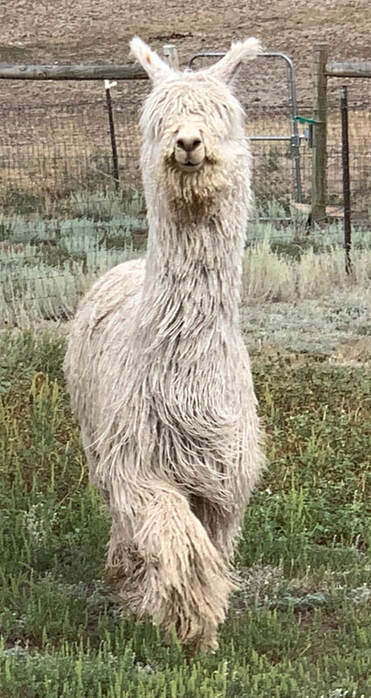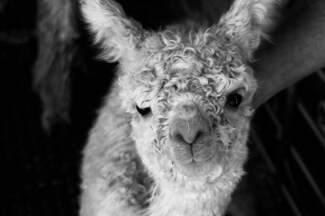|
|
|
|
Explore Alpacas and Alpaca Farming
This section will introduce you to alpacas and help you explore possible alpaca ownership.
On this page:
Materials for download: From the Camelid Community Standard of Care Working Group: From Suri Network:
|
Alpaca...
Originally from the high Andean Plateau and mountains of South America, alpaca were first imported into the United States in 1984. Today there are over 200,000 registered alpaca in the United States.
Members of the camelid family, alpaca are small animals, about three feet to the shoulders. Adult weight is between 120 and 175 pounds. They are small enough for even young children to handle, and are quiet, gentle animals. There are two types of alpaca: Suri and Huacaya. Huacaya have fiber that appears fluffy, much like sheep’s wool. Suri alpaca have long, silky fiber, which forms into locks much like dreadlocks. Approximately 10-15% of the world’s population of alpaca are Suri. We raise Suri alpaca on our farm. A central registry for alpacas is operated by the Alpaca Owners Association (AOA). The registry protects the existing gene pool and helps ensure each breeder's investment is protected from cross-breeding with other camelids. The registry is currently closed, which means that every alpaca that is registered must be DNA tested and validated as an offspring of two other ARI registered parents. We register all our alpaca, and only purchase alpaca who are registered or can be registered. |
Why alpacas?
Fiber!
Alpaca fiber was considered the “fiber of the gods” by Incan royalty, due to its luxurious feel. Alpaca fiber is strong, soft, and warm.
Alpaca yarn can be knitted, woven, crocheted, or felted. Some fabric experts say it is more resilient and wrinkle resistant than cashmere, with a lower tendency to shrink than either wool or cashmere. Handspinners and fiber artists love to work with the silky, cool fiber.
Alpaca fiber has little lanolin or other oils, so harsh chemicals are not needed to clean the fiber before processing. Many people who are allergic to wool can wear alpaca next to their skin with no problem. There is little or no scratchy, prickly feel like wool – just soft and smooth - due to the lack of scales on a single fiber.
Alpaca fiber provides warmth without heavy weight. Some say it is warmer than goose down, and breathes better than thermal knit. Alpaca is warmer than sheep’s wool. It also wicks away water! What better material for coats, gloves, scarves, socks, and sweaters?
Alpacas produce fleece in many natural colors, ranging from white to black. This extensive range reduces the need for artificial dyes and protects the softness and integrity of the fiber.
To top it off, alpaca fiber is nearly indestructible. Alpaca garments have been found in remarkably good condition in Peruvian ruins dating back 2500 years!
Personality!
Alpaca are intelligent, curious, calm, and gentle. They are quiet. As herd animals, alpaca move together and stay together. They form close and lasting relationships with each other and with us.
The babies, called cria, love to race and play on dirt piles. Sometimes the adults join in too. It is delightful to watch; some say that watching alpaca will lower one’s blood pressure by five points! And we believe that!
Care!
Alpaca can be raised relatively easily, compared to other livestock. Requiring little land – 5 to 7 per acre – alpaca need shelter from extreme weather, good forage, and small amounts of supplemental feed. They have soft padded feet and are “earth-friendly”. Alpaca generally create communal “poop piles”, which allows us to keep barns and pastures clean by cleaning up poop daily.
The daily routine includes providing hay, cleaning up, and feeding additional supplements as needed. And, of course, observing and interacting with these incredible beings!
Alpaca fiber was considered the “fiber of the gods” by Incan royalty, due to its luxurious feel. Alpaca fiber is strong, soft, and warm.
Alpaca yarn can be knitted, woven, crocheted, or felted. Some fabric experts say it is more resilient and wrinkle resistant than cashmere, with a lower tendency to shrink than either wool or cashmere. Handspinners and fiber artists love to work with the silky, cool fiber.
Alpaca fiber has little lanolin or other oils, so harsh chemicals are not needed to clean the fiber before processing. Many people who are allergic to wool can wear alpaca next to their skin with no problem. There is little or no scratchy, prickly feel like wool – just soft and smooth - due to the lack of scales on a single fiber.
Alpaca fiber provides warmth without heavy weight. Some say it is warmer than goose down, and breathes better than thermal knit. Alpaca is warmer than sheep’s wool. It also wicks away water! What better material for coats, gloves, scarves, socks, and sweaters?
Alpacas produce fleece in many natural colors, ranging from white to black. This extensive range reduces the need for artificial dyes and protects the softness and integrity of the fiber.
To top it off, alpaca fiber is nearly indestructible. Alpaca garments have been found in remarkably good condition in Peruvian ruins dating back 2500 years!
Personality!
Alpaca are intelligent, curious, calm, and gentle. They are quiet. As herd animals, alpaca move together and stay together. They form close and lasting relationships with each other and with us.
The babies, called cria, love to race and play on dirt piles. Sometimes the adults join in too. It is delightful to watch; some say that watching alpaca will lower one’s blood pressure by five points! And we believe that!
Care!
Alpaca can be raised relatively easily, compared to other livestock. Requiring little land – 5 to 7 per acre – alpaca need shelter from extreme weather, good forage, and small amounts of supplemental feed. They have soft padded feet and are “earth-friendly”. Alpaca generally create communal “poop piles”, which allows us to keep barns and pastures clean by cleaning up poop daily.
The daily routine includes providing hay, cleaning up, and feeding additional supplements as needed. And, of course, observing and interacting with these incredible beings!
Copyright 2024 Hasselbring's Harmony Ranch Hasselbring's Harmony Ranch 29049 Davis Road Concordia, Missouri 64020
816-809-7041 britt@hasselbringsharmonyranch.com
816-809-7041 britt@hasselbringsharmonyranch.com
